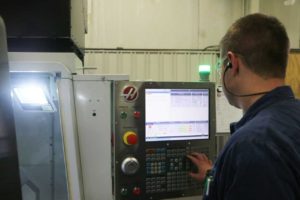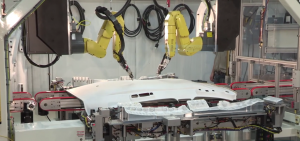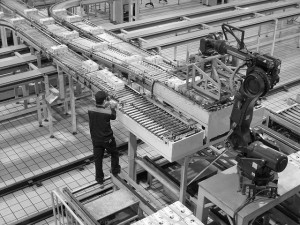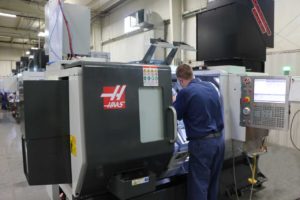At Koops, we are constantly looking for ways to improve our products, and it is with that goal in mind that we are excited to tell you about the latest addition to our Machining Department; the Computer Numerical Control Lathe – or CNC Lathe for short.
As you know, a lathe removes material by rotating a workpiece on a single axis of rotation. When controlled by a person, operating a lathe can take a good amount of time and is open to human error, creating lost manhours as well as possibly unusable pieces. We can program a sequence through the CNC Lathe that is then carried out to perfection every time, giving us maximum accuracy with minimal downtime. With the CNC Lathe's ability to sequence multiple actions, as well as its automatic tool presetter and spindle coolant system, we are able to produce high-quality parts at a rapid pace with little need for operator input.
This higher level of precision allows us to create the parts you require at a higher level of accuracy than ever before, and with a faster turnaround time. The CNC Lathe also gives us the ability to machine hardened steel components in-house, saving us the time and money that would have been lost with outsourcing the work.
All of this builds into the three promises we at Koops make to you:
Rock Solid Engineering Solutions
- The CNC Lathe improves the quality of the parts we offer
- The CNC Lathe cuts down on the time it will take to build the parts you need
- The CNC Lathe can create parts that far more accurate than a human hand could
Reliable Project Management
- The CNC Lathe allows us to create hardened steel components in-house
- The CNC Lathe increases efficiency and cuts down on labor costs
Excellent Customer Support
- The CNC Lathe gives us a new way to better meet your needs
 We hope that you can see the added benefits of the CNC Lathe. Our Machining Department has always been focused on producing high-quality components at a low cost, and the capabilities of the CNC Lathe helps us achieve this goal better than ever before.
We hope that you can see the added benefits of the CNC Lathe. Our Machining Department has always been focused on producing high-quality components at a low cost, and the capabilities of the CNC Lathe helps us achieve this goal better than ever before.
If you have any questions about the CNC Lathe or any of our other tools and capabilities, please contact our sales team at support@koops.com[:]
Headliner systems are one of the largest pieces of safety equipment in vehicles today. Dozens of individual components need to be assembled in just the right way and just the right place, so there is little room for error. The safety of the vehicle’s occupants may depend on it and the same can be said for an auto maker’s profitability. With reasons like that in mind, world-class automobile manufacturers are turning to the (HIC station) from Koops.
How Our Automated HIC Station Works
Using robotic technology, metered dispense systems, and advanced tooling design, our HIC station can help you efficiently and effectively assemble this important barrier of safety so it functions properly in the event of a roll-over accident. It also brings a variety of benefits to manufacturing headliners.
Here are the top five benefits you can count on when using an automated HIC Station from Koops, Inc.:
- Increased precision. Ensure that assembled component locations function as intended due to precise assembly.
- Consistent part-to-part cycle time. Match the broadcast rate from the plant with consistent cycle time due to automation.
- Tracking product serial numbers. Ensure that quality measures are achieved through the assembly process using serial numbers.
- Decreased scrap material. Allows all processes to be tuned to optimal parameters, reducing the scrap rate of assembled parts.
- Decreased risk of ergonomic issues. Operators do not have to interface with product during the automated cycle reducing the risk of repetitive strain injuries.
Improve Your Product and Process with an Automated HIC Station from Koops, Inc.
Long gone are the days of businesses that can be totally dependent on people to do the monotonous, rigorous, and often-times undesirable work within assembly lines. Technology has changed the nature of manufacturing over the years and changed it for the better.
Computers and robots have added great benefits to the manufacturing industry, and automation (like our HIC station) has provided a significant competitive advantage. In the world of vehicle manufacturing, this smart application of automation is especially important.
We specialize in factory automation systems at Koops and have designed and built innovative special machines and automated equipment for leading, world-class vehicle manufacturers. If you want this for your business, there is no time like the present to take the next step.
Click here to take a look and learn more about the HIC stations we have built. And if you have a headliner project, contact Koops today to discuss the benefits and awesome potential for building it all with manufacturing automation.
I n 1903, Henry Ford reimagined manufacturing, creating the first ever moving assembly line for mass production. Previously, a car took 12 hours to assemble, but after Ford’s innovation, it took two hours and 30 minutes. Since then, the history of production manufacturing is marked by continual advancements that redefine standards for efficiency, quality, speed, and accuracy. In more recent history, automation has been driving improvements in overall efficiency, cutting costs, and streamlining processes. Before making the investment, manufacturers need to decide when and what to automate to maximize the benefits.
n 1903, Henry Ford reimagined manufacturing, creating the first ever moving assembly line for mass production. Previously, a car took 12 hours to assemble, but after Ford’s innovation, it took two hours and 30 minutes. Since then, the history of production manufacturing is marked by continual advancements that redefine standards for efficiency, quality, speed, and accuracy. In more recent history, automation has been driving improvements in overall efficiency, cutting costs, and streamlining processes. Before making the investment, manufacturers need to decide when and what to automate to maximize the benefits.
Is it the right time?
A manufacturer first needs to determine if the ROI for automation justifies the expenditure. There are several primary justifications for automation that can help identify if it is the right time to automate.
- Minimize costs: Automation can minimize labor and training costs because employees receive training for the automation equipment instead of for multiple processes and machines on the line. This leads to less wasted materials and reduced expenses.
- Standardize and improve quality: Automation systems can easily, consistently, and precisely accomplish tasks that are hard to complete by hand, reducing the rate of piece part rejection. Furthermore, by implementing end-of-assembly testing equipment, total production manufacturing time can be minimized while quality is guaranteed.
- Reduce production times: Because production time is reduced, the work-in-process and finished goods inventories are also reduced. A manufacturer experiences a more flexible, improved response time if changes to the order or product are needed.
These three factors should help a manufacturer determine if it is time to automate. Since each automation system is completely customizable, a project manager can assist in identifying a solution that will optimize these benefits.
Which processes will benefit most?
A project manager will help decide which production manufacturing processes will benefit most from automation, but in the meantime, several factors can help manufacturers decide what to automate. Parts with the same or similar features and families of parts are top candidates for automation. Similarly, parts with the same or related processes greatly benefit from automation. If the current manufacturing production involves a flow line, which incorporates a partial or complete continual flow from station to station, an automation solution can further increase efficiency and reduce production time. In some cases, workspace integration can simplify and improve a flow line. Repeatable operations are also completed quickly and accurately with an automation solution. In general, if a part takes up around 80 percent of the volume and about 20 percent of parts numbers, production would benefit from automation.
These guidelines can help determine when and what to automate, but keep in mind that Koops, Inc. engineers can also customize a solution. No matter the scale of the project, an automation system can be tailored to each production manufacturing process, maximizing the benefits during each and every stage of production.
 We know that factory automation streamlines production for a more efficient process. However, before implementing a new system, a company needs to determine its’ specific automation goals and needs. With clearly defined objectives, the value and resources of each project will be optimized. Knowing what you need and want from your automation project may not be as simple as it sounds. Brainstorming, collaboration, communication, and many other analytical tools are required across departments for a successful project. Don’t be overwhelmed. Use these suggestions to define your goals and begin creating a more efficient production line.
We know that factory automation streamlines production for a more efficient process. However, before implementing a new system, a company needs to determine its’ specific automation goals and needs. With clearly defined objectives, the value and resources of each project will be optimized. Knowing what you need and want from your automation project may not be as simple as it sounds. Brainstorming, collaboration, communication, and many other analytical tools are required across departments for a successful project. Don’t be overwhelmed. Use these suggestions to define your goals and begin creating a more efficient production line.
Defining Automation Goals
- Create a team to examine the project and implement a strategy. Ideally, the members of this team should include employees from every department involved with the project.
- Place one person in charge to manage the project. This person will have final responsibility for the entire process, including communication with all suppliers.
- A Technical Specification (Tech Spec) is a document that defines specific goals of the project, including expectations for design and performance of the factory automation system. The project manager should be holding regular meetings and combining input from multiple departments to form a detailed Tech Spec.
- Justification is often the most challenging aspect of planning. Before placing an order, management and the project team must be willing to commit to the value of the investment. Justification involves analysis of efficiency, quality, safety, value, and management to determine the desired ROI. Prioritizing or adding dollar amounts to certain capacities could help reveal the most important aspects of the project.
- If management and the project team agree that the investment is worth the ROI, then the project manager can begin searching for a supplier with clearly defined goals. If there is disagreement, then the project team needs to rework the Tech Spec to include as many capacities as possible within the budget.
Creating clear and concise goals requires collaboration across departments, but with open communication, specifically around desired capacities and budget, the main objectives will become well-defined. After goals have been agreed upon, it's easier to integrate a finely tuned automated system into a business to streamline work processes, increase worker safety, and enhance overall company output.
Photo Credit: Cory M. Grenier
